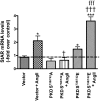Angiotensin II-induced protein kinase D activates the ATF/CREB family of transcription factors and promotes StAR mRNA expression
- PMID: 24708239
- PMCID: PMC4060184
- DOI: 10.1210/en.2013-1485
Angiotensin II-induced protein kinase D activates the ATF/CREB family of transcription factors and promotes StAR mRNA expression
Abstract
Aldosterone synthesis is initiated upon the transport of cholesterol from the outer to the inner mitochondrial membrane, where the cholesterol is hydrolyzed to pregnenolone. This process is the rate-limiting step in acute aldosterone production and is mediated by the steroidogenic acute regulatory (StAR) protein. We have previously shown that angiotensin II (AngII) activation of the serine/threonine protein kinase D (PKD) promotes acute aldosterone production in bovine adrenal glomerulosa cells, but the mechanism remains unclear. Thus, the purpose of this study was to determine the downstream signaling effectors of AngII-stimulated PKD activity. Our results demonstrate that overexpression of the constitutively active serine-to-glutamate PKD mutant enhances, whereas the dominant-negative serine-to-alanine PKD mutant inhibits, AngII-induced StAR mRNA expression relative to the vector control. PKD has been shown to phosphorylate members of the activating transcription factor (ATF)/cAMP response element binding protein (CREB) family of leucine zipper transcription factors, which have been shown previously to bind the StAR proximal promoter and induce StAR mRNA expression. In primary glomerulosa cells, AngII induces ATF-2 and CREB phosphorylation in a time-dependent manner. Furthermore, overexpression of the constitutively active PKD mutant enhances the AngII-elicited phosphorylation of ATF-2 and CREB, and the dominant-negative mutant inhibits this response. Furthermore, the constitutively active PKD mutant increases the binding of phosphorylated CREB to the StAR promoter. Thus, these data provide insight into the previously reported role of PKD in AngII-induced acute aldosterone production, providing a mechanism by which PKD may be mediating steroidogenesis in primary bovine adrenal glomerulosa cells.
Figures






Similar articles
-
Very low-density lipoprotein (VLDL)-induced signals mediating aldosterone production.J Endocrinol. 2017 Feb;232(2):R115-R129. doi: 10.1530/JOE-16-0237. Epub 2016 Dec 2. J Endocrinol. 2017. PMID: 27913572 Free PMC article. Review.
-
c-Fos mediates angiotensin II-induced aldosterone production and protein synthesis in bovine adrenal glomerulosa cells.Endocrinology. 2009 Mar;150(3):1294-302. doi: 10.1210/en.2008-1036. Epub 2008 Oct 30. Endocrinology. 2009. PMID: 18974265
-
Protein kinase C and Src family kinases mediate angiotensin II-induced protein kinase D activation and acute aldosterone production.Mol Cell Endocrinol. 2014 Jul 5;392(1-2):173-81. doi: 10.1016/j.mce.2014.05.015. Epub 2014 May 22. Mol Cell Endocrinol. 2014. PMID: 24859649 Free PMC article.
-
Chicken ovalbumin upstream promoter-transcription factor is a negative regulator of steroidogenesis in bovine adrenal glomerulosa cells.Mol Endocrinol. 2005 Jan;19(1):65-75. doi: 10.1210/me.2004-0061. Epub 2004 Sep 16. Mol Endocrinol. 2005. PMID: 15375188
-
The control by angiotensin II of cholesterol supply for aldosterone biosynthesis.Mol Cell Endocrinol. 2004 Mar 31;217(1-2):113-8. doi: 10.1016/j.mce.2003.10.055. Mol Cell Endocrinol. 2004. PMID: 15134809 Review.
Cited by
-
Very low-density lipoprotein (VLDL)-induced signals mediating aldosterone production.J Endocrinol. 2017 Feb;232(2):R115-R129. doi: 10.1530/JOE-16-0237. Epub 2016 Dec 2. J Endocrinol. 2017. PMID: 27913572 Free PMC article. Review.
-
Loss of CREB Coactivator CRTC1 in SF1 Cells Leads to Hyperphagia and Obesity by High-fat Diet But Not Normal Chow Diet.Endocrinology. 2021 Sep 1;162(9):bqab076. doi: 10.1210/endocr/bqab076. Endocrinology. 2021. PMID: 33846709 Free PMC article.
-
Aldosterone-Regulated Sodium Transport and Blood Pressure.Front Physiol. 2022 Feb 7;13:770375. doi: 10.3389/fphys.2022.770375. eCollection 2022. Front Physiol. 2022. PMID: 35197862 Free PMC article. Review.
-
VLDL-activated cell signaling pathways that stimulate adrenal cell aldosterone production.Mol Cell Endocrinol. 2016 Sep 15;433:138-46. doi: 10.1016/j.mce.2016.05.018. Epub 2016 May 21. Mol Cell Endocrinol. 2016. PMID: 27222295 Free PMC article.
-
The Herbicide Atrazine Potentiates Angiotensin II-Induced Aldosterone Synthesis and Release From Adrenal Cells.Front Endocrinol (Lausanne). 2021 Jul 14;12:697505. doi: 10.3389/fendo.2021.697505. eCollection 2021. Front Endocrinol (Lausanne). 2021. PMID: 34335472 Free PMC article.
References
-
- Müller J. Aldosterone: the minority hormone of the adrenal cortex. Steroids. 1995;60(1):2–9 - PubMed
-
- Quinn SJ, Williams GH. Regulation of aldosterone secretion. Annu Rev Physiol. 1988;50:409–426 - PubMed
-
- Calhoun DA. Aldosterone and cardiovascular disease: smoke and fire. Circulation. 2006;114:2572–2574 - PubMed
-
- Delcayre C, Swynghedauw B. Molecular mechanisms of myocardial remodeling. The role of aldosterone. J Mol Cell Cardiol. 2002;34(12):1577–1584 - PubMed
-
- Rocha R, Stier CT, Jr, Kifor I, et al. Aldosterone: a mediator of myocardial necrosis and renal arteriopathy. Endocrinology. 2000;141(10):3871–3878 - PubMed
Publication types
MeSH terms
Substances
Grants and funding
LinkOut - more resources
Full Text Sources
Other Literature Sources
Molecular Biology Databases

